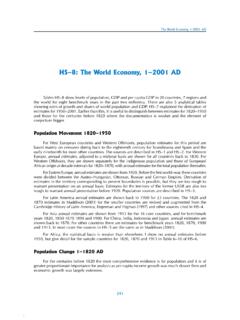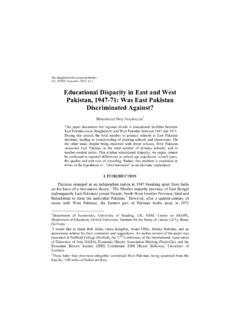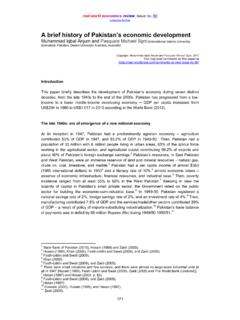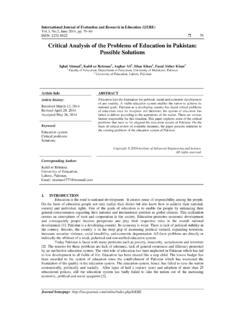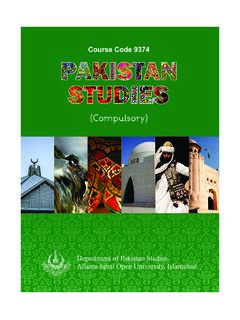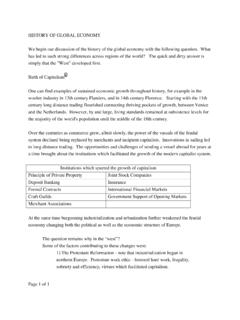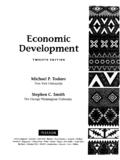Transcription of The Economic and Social Impact of Colonial Rule in India ...
1 The Economic and Social Impact of Colonial Rule in India Chapter 3 of Class Structure and Economic Growth: India & Pakistan since the Moghuls Maddison (1971). British imperialism was more pragmatic than that of other Colonial powers. Its motivation was Economic , not evangelical. There was none of the dedicated Christian fanaticism which the Portuguese and Spanish demonstrated in Latin America and less enthusiasm for cultural diffusion than the French (or the Americans) showed in their colonies. For this reason they westernized India only to a limited degree. British interests were of several kinds. At first the main purpose was to achieve a monopolistic trading position. Later it was felt that a regime of free trade would make India a major market for British goods and a source of raw materials, but British capitalists who invested in India , or who sold banking or shipping service there, continued effectively to enjoy monopolistic privileges.
2 India also provided interesting and lucrative employment for a sizeable portion of the British upper middle class, and the remittances they sent home made an appreciable contribution to Britain's balance of payments and capacity to save. Finally, control of India was a key element in the world power structure, in terms of geography, logistics and military manpower. The British were not averse to Indian Economic development if it increased their markets but refused to help in areas where they felt there was conflict with their own Economic interests or political security. Hence, they refused to give protection to the Indian textile industry until its main competitor became Japan rather than Manchester, and they did almost nothing to further technical education. They introduced some British concepts of property, but did not push them too far when they met vested interests.
3 The main changes which the British made in Indian society were at the top. They replaced the wasteful warlord aristocracy by a bureaucratic-military establishment, carefully designed by utilitarian technocrats, which was very efficient in maintaining law and order. The greater efficiency of government permitted a substantial reduction in the fiscal burden, and a bigger share of the national product was available for landlords, capitalists and the new professional classes. Some of this upper class income was siphoned off to the UK, but the bulk was spent in India . However, the pattern of consumption changed as the new upper class no longer kept harems and palaces, nor did they wear fine muslins and damascened swords. This caused some painful readjustments in the traditional handicraft sector. It seems likely that there was some increase in productive investment which must have been near zero in Moghul India : government itself carried out productive investment in railways and irrigation and as a result there was a growth in both agricultural and industrial output.
4 The new elite established a Western life-style using the English language and 1. English schools. New towns and urban amenities were created with segregated suburbs and housing for them. Their habits were copied by the new professional elite of lawyers, doctors, teachers, journalists and businessmen. Within this group, old caste barriers were eased and Social mobility increased. As far as the mass of the population were concerned, Colonial rule brought few significant changes. The British educational effort was very limited. There were no major changes in village society, in the caste system, the position of untouchables, the joint family system, or in production techniques in agriculture. British Impact on Economic and Social development was, therefore, limited. Total output and population increased substantially but the gain in per capita output was small or negligible.
5 It is interesting to speculate about India 's potential Economic fate if it had not had two centuries of British rule. There are three major alternatives which can be seriously considered. One would have been the maintenance of indigenous rule with a few foreign enclaves, as in China. Given the fissiparous forces in Indian society, it is likely that there would have been major civil wars in China in the second half of the nineteenth century and the first half of the twentieth century and the country would probably have split up. Without direct foreign interference with its educational system, it is less likely that India would have developed a modernizing intelligentsia than China because Indian society was less rational and more conservative, and the Chinese had a much more homogeneous civilization around which to build their reactive nationalism.
6 If this situation had prevailed, population would certainly have grown less but the average standard of living might possibly have been a little higher because of the bigger upper class, and the smaller drain of resources abroad (1). Another alternative to British rule would have been conquest and maintenance of power by some other West European country such as France or Holland. This probably would not have produced results very different in Economic terms from British rule. The third hypothesis is perhaps the most intriguing, conquest by a European power, with earlier accession to independence. If India had had self-government from the 1880s, after a century and a quarter of British rule, it is likely that both income and population growth would have been accelerated. There would have been a smaller drain of investible funds abroad, greater tariff protection, more state enterprise and favours to local industry, more technical training - the sort of things which happened after 1947.
7 However, India would probably not have fared as well as Meiji Japan, because the fiscal leverage of government would have been smaller, zeal for mass education less, and religious and caste barriers would have remained as important constraints on productivity. Establishment of a New Westernized Elite The biggest change the British made in the Social structure was to replace the warlord aristocracy by an efficient bureaucracy and army. The traditional system of the East India Company had been to pay its servants fairly modest salaries, and to let them augment their income from 2. private transactions. This arrangement worked reasonably well before the conquest of Bengal, but was inefficient as a way of remunerating the officials of a substantial territorial Empire because (a). too much of the profit went into private hands rather than the Company's coffers, and (b) an over- rapacious short-term policy was damaging to the productive capacity of the economy and likely to drive the local population to revolt, both of which were against the Company's longer-term interests.
8 Clive had operated a 'dual' system, Company power and a puppet Nawab. Warren Hastings displaced the Nawab and took over direct administration, but retained Indian officials. Finally, in 1785, Cornwallis created a professional cadre of Company servants who had generous salaries, had no private trading or production interests in India , enjoyed the prospect of regular promotion and were entitled to pensions (2). All high-level posts were reserved for the British, and Indians were excluded. Cornwallis appointed British judges, and established British officials as revenue collectors and magistrated in each district of Bengal. From 1806 the Company trained its young recruits in Haileybury College near London. Appointments were still organized on a system of patronage, but after 1833 the Company selected amongst its nominated candidates by competitive examination.
9 After 1853, selection was entirely on merit and the examination was thrown open to any British candidate. The examination system was influenced by the Chinese model, which had worked well for 2,000 years and had a similar emphasis on classical learning and literary competence. The Indian civil service was therefore able to secure high quality people because (a) it was very highly paid; (b) it enjoyed political power which no bureaucrat could have had in England. In 1829 the system was strengthened by establishing districts throughout British India small enough to be effectively controlled by an individual British official who henceforth exercised a completely autocratic power, acting as revenue collector, judge and chief of police (functions which had been separate under the Moghul administration). This arrangement later became the cornerstone of Imperial administration throughout the British Empire.
10 As the civil service was ultimately subject to the control of the British parliament, and the British community in India was subject to close mutual surveillance, the administration was virtually incorruptible. The army of the Company was a local mercenary force with 20,000-30,000 British officers and troops. It was by far the most modern and efficient army in Asia. After the Mutiny in 1857, the size of the British contingent was raised to a third of the total strength and all officers were British until the 1920s when a very small number of Indians was recruited. Normally, the total strength of the army was about 200,000. This army was very much smaller than those of Moghul India ,3 but had better training and equipment, and the railway network (which was constructed partly for military reasons) gave it greater mobility, better logistics and intelligence.


